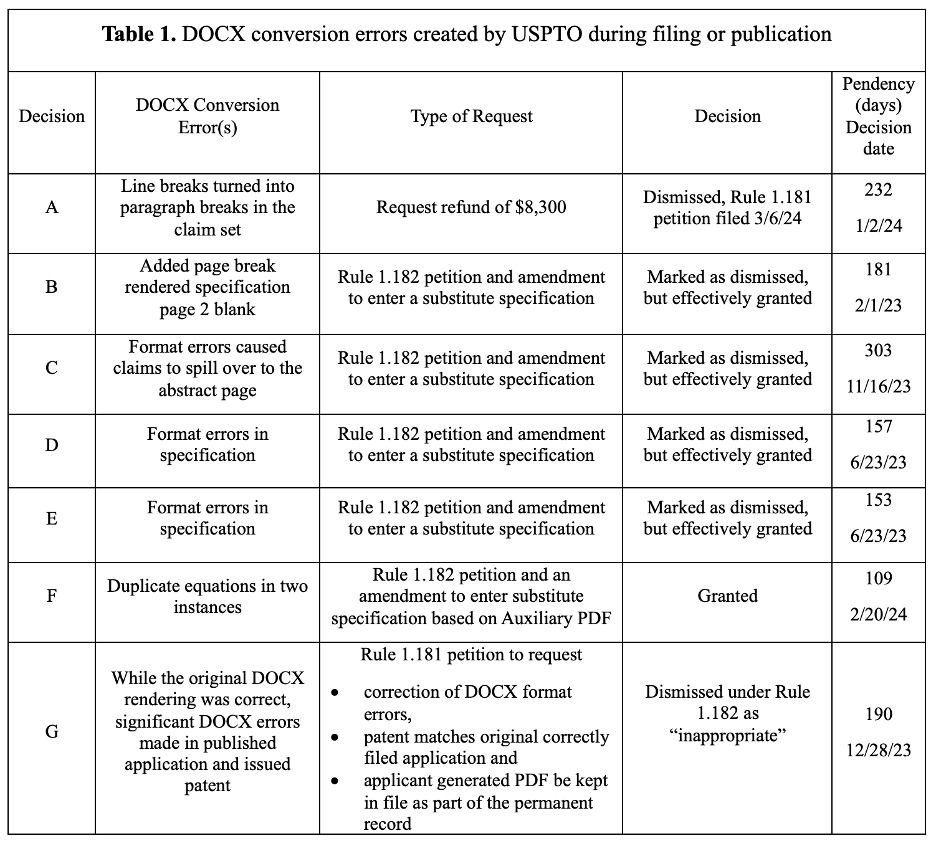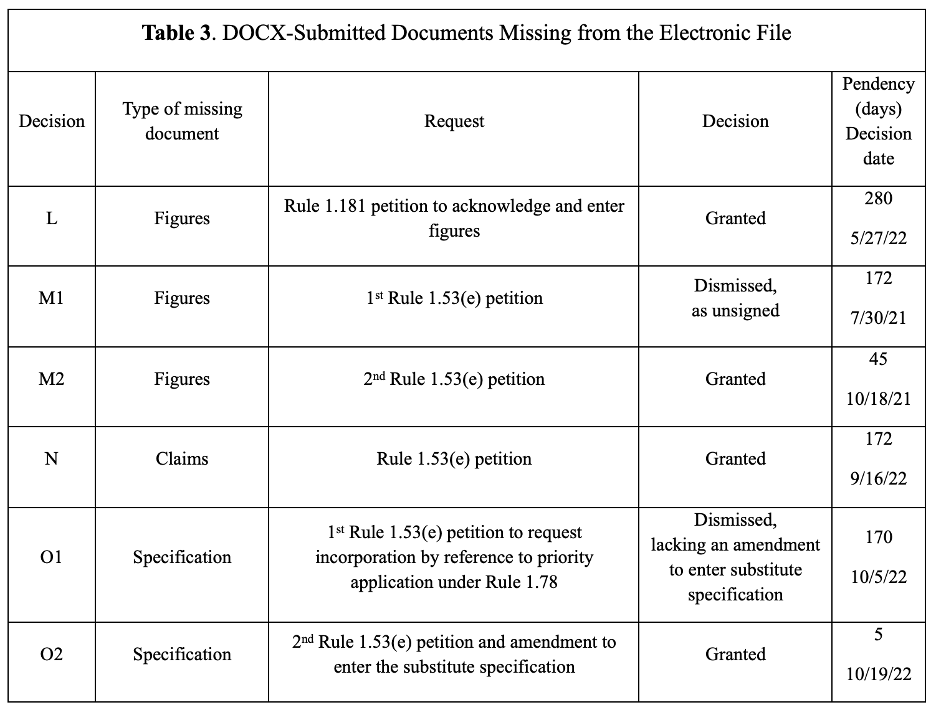The Trains, Planes and Automobiles of Correcting DOCX-Related Errors
“We found significant delays in the processing of patent applications with actual or perceived (i.e., uploaded documents ‘missing’ from the official file) DOCX-related errors.”
Similar to Steve Martin and John Candy’s calamitous odyssey in the classic 1980s film Planes, Trains and Automobiles, patent practitioners are experiencing their own misadventures when filing applications in the DOCX format. As of January 17, 2024, the U.S. Patent and Trademark Office (USPTO) mandated submitting all specification, claims and abstracts of non-provisional applications filed under 35 U.S.C. 111(a) in DOCX format or incurring a $400 surcharge (non-discounted). The DOCX mandate came after thousands, and likely tens of thousands, of practitioners, directly or indirectly, communicated their significant procedural, technical, legal, ethical, professional liability, and financial concerns to the USPTO as you can read HERE, HERE, HERE, HERE, HERE, and HERE. As David Boundy of Potomac Law Group PLLC explained HERE, DOCX was not designed for archival purposes or to ensure that on-screen behavior is uniform across all computers.
In apparent response to such concerns, the USPTO has extended until further notice the option to upload a backup (auxiliary) PDF version of their application with their DOCX version. While no fees are associated with this auxiliary PDF (HERE), doubts remain as to how the auxiliary PDF can be relied upon to correct USPTO rendering mistakes (HERE).
According to the Frequently Asked Question, “How do I report and/or correct any perceived discrepancies in my file?”, on the USPTO’s DOCX website (HERE), applicants are directed, with some caveats, to file petitions under Rule 1.181, 1.182, or rely on Rule 1.57(b) to incorporate by reference disclosures earlier filed under Rule 1.55 or Rule 1.78.
In order to identify the types of errors which are occurring and how these errors are being addressed by applicants and the USPTO, we searched Petition.ai’s database of over 1 million patent petition decisions filed with the USPTO. We identified 19 petitions related to correcting issues in 16 unique DOCX-filed applications. All 16 decisions pertained to errors that occurred in filings before January 17, 2024, when the DOCX surcharge mandate went into effect. We consider this sample the tip of the DOCX-iceberg and fully expect, as additional DOCX-filed applications are published and corresponding DOCX-related petitions become public, we will learn more about the prevalence of DOCX-associated errors and how the USPTO is handling practitioners’ attempts to correct them.
In our sample of 19 petitions, we found four main types of errors:
- DOCX conversion errors
- Applicants’ inadvertent submission of extraneous documents
- DOCX-submitted documents missing from the electronic file, and
- Fees charged to correct USPTO-generated errors.
DOCX Conversion Errors
Table 1 provides examples of errors created by the USPTO’s DOCX conversion process during filing, publication, or issuance of the patent. None of these USPTO-generated behind-the-scenes changes would be easily detected by applicants, but each had a significant impact on their applications.
Highlights from Table 1 include:
- Decision A – The seemingly innocuous conversion of line breaks into paragraph breaks throughout a claim set resulted in $8,300 excess claim fees
- Decision B – A page break created a blank page 2 of the specification, prompting a Notice of Omitted Items
- Decisions C, D, and E – An inserted page break caused a portion of the claims to spill over onto the Abstract sheet, and
- Decision F – Equations were duplicated in two instances.
- Decisions B – F – Applicant’s submission of an amendment containing a substitute specification under Rule 1.121(b)(3) was sufficient to correct the USPTO’s errors. The accompanying Rule 1.182 petitions were deemed unnecessary, despite USPTO’s guidance to file a Rule 1.182 petition in this circumstance.
- Decision G – Applicant filed in DOCX format along with an Auxiliary PDF. When the patent application published in March 2023, significant errors were made during DOCX-conversion including font changes, character changes, spacing changes, paragraph numbering, paragraph formatting changes, and equation formatting changes (an
was twice changed to
). This applicant filed a Rule 1.181 petition to correct the electronic record based on the DOCX submissions filed less than one year earlier. During the 190 days the USPTO took to dismiss the petition, the patent issued in July 2023 with more DOCX format errors. The decision styled under Rule 1.182 (not Rule 1.181 as filed) indicated there are other ways to correct patent applications (Rule 1.221, MPEP 1130) or correct an issued patent (Rule 1.322, MPEP 1480), so the petition was “dismissed as inappropriate”. Noteworthy, Decision G did not address the applicant’s request that the Auxiliary PDF be kept in the file as part of the permanent record.
Applicant’s Inadvertent Submission of Extraneous Documents
The second type of error arose by applicant’s inadvertent submission of extraneous documents. Unlike the legacy PDF filing process, where only one version of the specification, claims, abstract and figures is submitted, to avoid DOCX processing risks, applicants have been submitting auxiliary PDFs of their filing papers. This duplicate filing process introduces the opportunity for mistakes such as those identified in Table 2.
When applicants file a paper which does not belong in the patent application, the procedural error can often be corrected by way of a Rule 1.59 petition to expunge. Applicants’ petitions to expunge such inadvertently filed documents were dismissed by the Office of Petitions in Decisions H, I, and J under the rationale that any specification, figures or claims which are submitted on the application’s filing date are un-expungable under Rule 1.59(a). Applicants were given the option of filing a Rule 1.83 petition to request that the rules be waived or suspended. It will be interesting to see if any such petitions are filed and how they are handled. However, when the similar fact pattern came before a Technology Center Group Director in Decision K, the petition was granted under 1.59(b) and the erroneously submitted auxiliary PDF removed from the official file.
DOCX-Submitted Documents Missing from the Electronic File
A third type of error occurred when documents submitted via DOCX were lost within the USPTO’s electronic file records. Examples of applications which appeared in the official electronic file to be missing the specification, claims, abstract or figures, even though such documents had been submitted in DOCX format, are shown in Table 3. Other users have reported DOCX-submitted documents missing from their applications too, a problem which some have attributed to glitches in Patent Center.
When required filing papers are missing, the USPTO holds the application as incomplete in view of applicant error and postpones granting a filing date until applicants respond to the Notice of Missing Parts or Notice of Omitted Items. In Decisions L, M, N and O, applicants filed petitions under Rule 1.53(e) along with amendments to enter the figures or claims and obtain their filing date. In Decisions L and M, the USPTO retrieved the originally filed figures and scanned them into the electronic file. While the USPTO’s DOCX webpage suggests filing a Rule 1.181 petition in this situation, the Office readily accepted Rule 1.53 petitions. In several instances, it appeared a call to the Electronic Business Center may have resolved the initial problem without filing any type of petition. However, ever after correction, these DOCX glitches can haunt applicants down the road, as prosecution delaying errors attributed to applicant impact future Patent Term Adjustment (PTA) determinations.
Fees Charged to Correct USPTO-Generated Errors
The last type of error involved fees being charged by the USPTO to correct USPTO-generated errors made during the DOCX submission. Table 4.
When the USPTO’s DOCX conversion process transformed line breaks into paragraph breaks throughout a claim set, Applicants were charged $8,300 in excess claim fees (Decision A). The initial request for a refund was dismissed after 232 days, with the rationale that since applicants had provided a blanket authorization to charge any necessary fees, the excess fees had not been paid in error. A Rule 1.181 petition with a renewed request for refund is awaiting decision.
The USPTO has assured the IP community it will waive the petition fee under 37 CFR 1.17(f) for petitions filed under Rule 1.182. In several cases, the Rule 1.182 petition fee was not initially charged (Decision C), was waived pursuant to 87 FR 26226 (Decision F), or was refunded (Decisions L, M2 and N). However, Decisions B, D and E did not waive or refund the petition fee.
Even though the IP community was assured that no fees would be associated with providing a backup, auxiliary PDF, $420 in application size fees were charged for Decision P’s Auxiliary PDF. Relying on applicant’s blanket statement for extra fee authorization, the Office of Petitions maintained the decision that the application size fees had not been paid in error, so it would not be refunded.
DOCX-Induced Errors Cause DOCX-Induced Delays
As a former USPTO employee for 20 years, I recall a saying at the Office: trying to get an off-track patent application back into the examination process is like hoisting a refrigerator back onto a conveyer belt. Our survey shows the USPTO has a difficult time getting applications with DOCX-induced errors back onto the patent examination conveyer belt.
We found significant delays in the processing of patent applications with actual or perceived (i.e., uploaded documents “missing” from the official file) DOCX-related errors. Since submission in DOCX format, applications A, B, F, I, J, and O have languished in pre-examination status for an average of 433 days from filing date, with a range of delay being 213 – 585 days.
Typically, the USPTO removes petitioned applications from the examination pipeline so no substantive action on the merits occurs until after the procedural matter is decided. In several instances related to DOCX-related errors, this was not done. For example, Decision K, requesting an extraneous Auxiliary PDF be expunged from the application, was mailed 353 days after filing and 22 days after an intervening action on the merits. Another example, Decision G, requesting the USPTO correct significant format errors in their publication, was dismissed 190 days after filing and 156 days after the USPTO repeated the DOCX rendering errors in the issued patent.
DOCX-related requests and petitions are slowly decided—on average in 167 days. The shortest pendency of five days (Decision O2) indicates the USPTO has the ability to process the petitions in a more expeditious manner. With petition processing waits up to 353 days (Decision K), these extensive petition processing delays to correct applications which have run afoul of the DOCX filing requirements contradict one of the USPTO’s rationale for adopting the DOCX process—to strengthen their ability to examine applications quickly and effectively.
What’s an IP Practitioner Supposed to Do?
In order to master the USPTO’s DOCX formats, practitioners have been recently advised to “[c]ompare the documents to ensure no unintentional changes are there. Mark this is a mandatory step. You must compare the User-submitted DOCX to the USPTO-generated DOCX; the User-submitted DOCX to the USPTO-generated PDF; a User-submitted PDF to the USPTO-generated DOCX; and the User-submitted PDF to the USPTO-generated PDF.”
To quote Steve Martin’s character in Planes, Trains and Automobiles, “But how are we supposed to go with the flow” when the arduous, time-consuming review time for each and every DOCX submission would easily cost patent practitioners and inventors more than the $400 (undiscounted) non-DOCX surcharge. Attempts to fix the DOCX-related errors which arose in Applications A-P surveyed here have likely cost significantly more than $400 in patent practitioners’ time and USPTO filing fees.
As noted HERE, while larger firms with more staff may have the time and resources to review the various documents for USPTO-induced errors, smaller firms and solo practitioners may not.
A February 28, 2024 survey of over 150 law firms and corporations indicated 50% of the responders generally planned to avoid submitting applications in DOCX format. It is difficult to place a cost on DOCX-induced processing delays, including unnecessary notice of omitted parts, examination delays, lengthy petition decision delays and possible reductions in PTA. These early results reinforce the idea that avoiding the entire DOCX road trip by paying $400 toll to file patent applications via the legacy PDF process makes more sense than trying to navigate through the madness and risking these DOCX-induced headaches.
USPTO Responds
USPTO Commissioner for Patents Vaishali Udupa sent the following statement to IPWatchdog in response to a summary of the claims made in this article:
We are experiencing historically high percentages of eligible filings in DOCX format, and we are so thankful to practitioners who have worked with us since the beginning to provide feedback, share concerns and suggestions, and make this transition a success. Since the January 17 transition date, 90 percent of eligible filings in Patent Center have been in the DOCX format. Additionally, the auxiliary pdf option has been a successful way for stakeholders to have enhanced confidence in their filings as we continue to build trust in filing in the DOCX format.
Having said that, we know change is never easy, and there will always be bumps in the road in any transition. We are always listening. We encourage all practitioners to report any and every issue they experience to our Electronic Business Center so that we can quickly address and resolve it. We also welcome stakeholders to join us at our DOCX training sessions and visit our Patent Center page for useful tips and information. By working together, we can drive further progress and ensure all patent applicants have the best experience possible.
Image Source: Deposit Photos
Author: illustrator_hft
Image ID: 14844783










